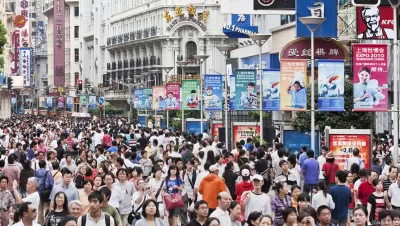China recently announced ambitious plans to move 100 million former farmers to urban environments—enough to bring the country's urban population to 60 percent of its total.

Ian Johnson reports on a new plan by China to rapidly urbanize its population. The plan, which would bring an additional 100 million residents out of the country and into the country’s urban settings, states that “urbanization is modernization” and “urbanization is an inevitable requirement for promoting social progress…”
If its goals are met, China would rebalance the country’s population to 60 percent urban by 2020. The plan is actually a scaled-back version of a proposal last year. “The plan floated last year by the government’s powerful planning commission called for 70 percent of the country’s nearly 1.4 billion population to be living in cities by 2025. The current plan aims for 60 percent by 2020,” writes Johnson.
The plan includes “30 chapters, covering topics that include Internet access, building standards, environmental protection and safety.” But the “most ambitious part of the urbanization plan is to better integrate former rural residents who are currently living in cities.” To do so, the plan will “[provide] better access to schools and hospitals for 100 million former farmers already living in cities but currently denied many basic services. Underpinning these projections would be government spending to build roads, railways, hospitals, schools and housing.”
FULL STORY: China Releases Plan to Incorporate Farmers Into Cities

Alabama: Trump Terminates Settlements for Black Communities Harmed By Raw Sewage
Trump deemed the landmark civil rights agreement “illegal DEI and environmental justice policy.”

Planetizen Federal Action Tracker
A weekly monitor of how Trump’s orders and actions are impacting planners and planning in America.

The 120 Year Old Tiny Home Villages That Sheltered San Francisco’s Earthquake Refugees
More than a century ago, San Francisco mobilized to house thousands of residents displaced by the 1906 earthquake. Could their strategy offer a model for the present?

In Both Crashes and Crime, Public Transportation is Far Safer than Driving
Contrary to popular assumptions, public transportation has far lower crash and crime rates than automobile travel. For safer communities, improve and encourage transit travel.

Report: Zoning Reforms Should Complement Nashville’s Ambitious Transit Plan
Without reform, restrictive zoning codes will limit the impact of the city’s planned transit expansion and could exclude some of the residents who depend on transit the most.

Judge Orders Release of Frozen IRA, IIJA Funding
The decision is a victory for environmental groups who charged that freezing funds for critical infrastructure and disaster response programs caused “real and irreparable harm” to communities.
Urban Design for Planners 1: Software Tools
This six-course series explores essential urban design concepts using open source software and equips planners with the tools they need to participate fully in the urban design process.
Planning for Universal Design
Learn the tools for implementing Universal Design in planning regulations.
Clanton & Associates, Inc.
Jessamine County Fiscal Court
Institute for Housing and Urban Development Studies (IHS)
City of Grandview
Harvard GSD Executive Education
Toledo-Lucas County Plan Commissions
Salt Lake City
NYU Wagner Graduate School of Public Service





























